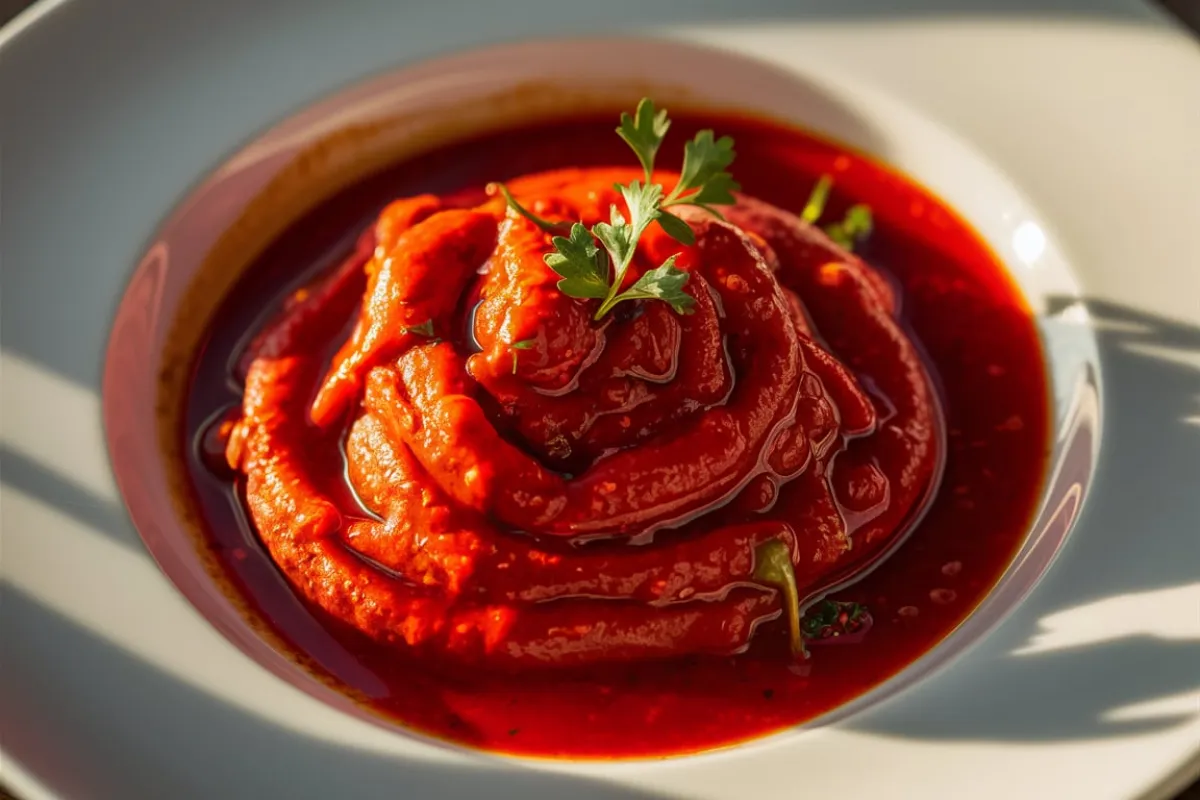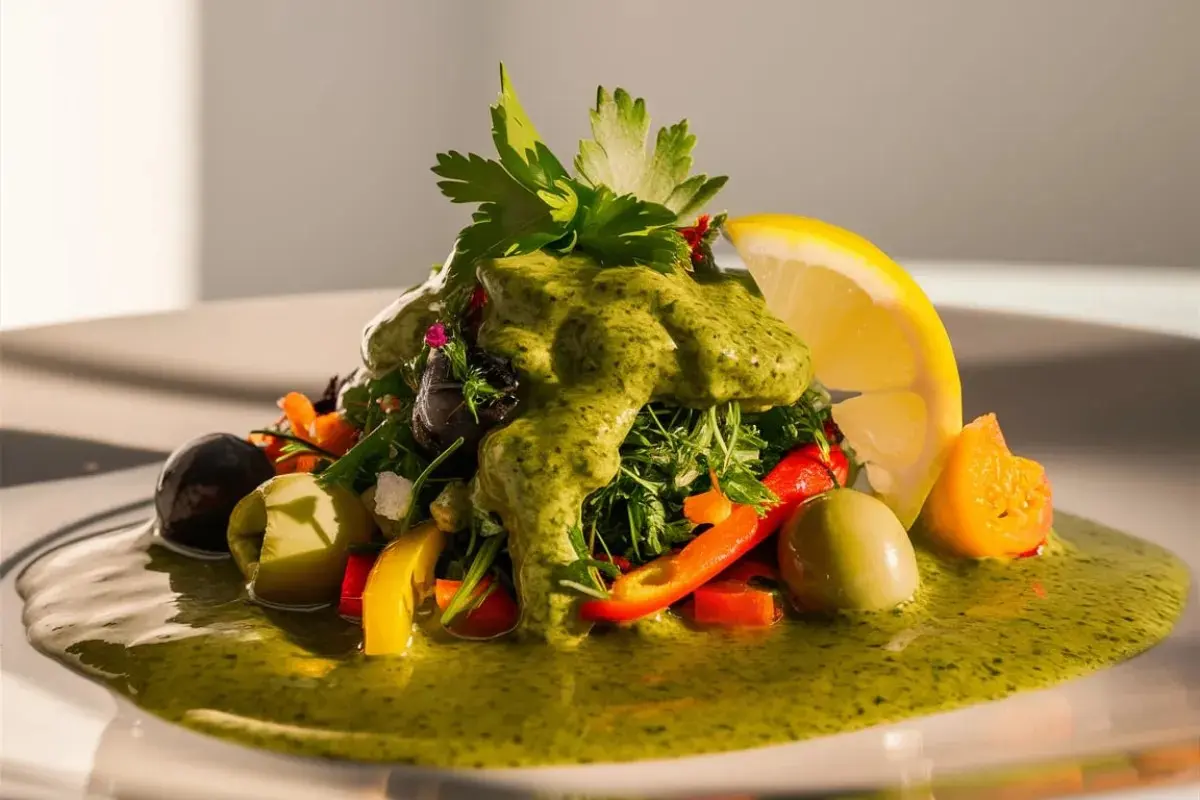Skhug Sauce, also known as zhug or s’chug, is a spicy, herbaceous sauce originating from Yemeni cuisine. Known for its vibrant flavor, fiery heat, and fresh herbal notes, Skhug has become a beloved condiment in Middle Eastern kitchens and beyond. Whether you enjoy it as a dip, spread, or marinade, Skhug’s versatility and bold flavor make it a must-try for anyone looking to spice up their meals.
History of Skhug Sauce
Skhug’s journey begins in Yemen, where it was traditionally made with fresh herbs, spices, and fiery chilies. The sauce spread to other regions, particularly Israel, through Yemeni Jewish immigrants, quickly becoming a staple in the broader Middle Eastern culinary scene. Skhug’s popularity grew as it began appearing alongside classic dishes like shawarma, falafel, and grilled meats, enhancing them with its distinct spicy kick.
The evolution of Skhug reflects the rich history of the Middle East, blending local ingredients with global influences. Over time, variations of Skhug Sauce began to emerge, each tailored to local tastes and available ingredients. Today, you’ll find Skhug not just in traditional Middle Eastern markets but also on supermarket shelves worldwide, celebrated for its ability to elevate both familiar and novel dishes.
Types of Skhug Sauce: Green, Red, and Brown Variations

Skhug Sauce comes in various forms, each with a unique blend of ingredients that result in different flavors and levels of spiciness. The most common types include:
- Green Skhug: The traditional version made with green chilies, fresh cilantro, garlic, and a mix of spices. It’s known for its fresh, bright flavor and intense heat, making it a favorite among spice lovers.
- Red Skhug: Made with red chilies instead of green, this version has a slightly sweeter undertone but maintains the characteristic spiciness. The addition of red bell peppers in some recipes can also add a smoky depth to the flavor.
- Brown Skhug: A less common variety that includes ingredients like tomatoes, adding a slightly tangy and rich flavor. This version is often used as a base for stews and marinades, providing a complex layer of spice.
Each type of Skhug has its own unique charm, allowing for endless possibilities in the kitchen. From the herbaceous punch of Green Skhug to the smoky sweetness of Red Skhug, there’s a version to suit every taste preference.
Ingredients of Skhug Sauce: What Makes This Spicy Sauce Special
The bold, vibrant flavor of Skhug comes from its simple yet powerful ingredients. While recipes can vary slightly depending on the type, the core ingredients remain consistent:
- Chilies: The star of Skhug, chilies bring the heat. Green or red chilies are typically used, depending on the type of Skhug. For those who prefer a milder version, jalapeños can replace hotter chilies.
- Fresh Herbs: Cilantro is the primary herb used in Skhug, adding a fresh, grassy note that balances the heat. Parsley is also occasionally added for an extra burst of flavor and color.
- Garlic: Adds a pungent depth that enhances the overall flavor of the sauce.
- Spices: Common spices include ground cumin, coriander, and cardamom, which provide warmth and complexity. These spices are often toasted to release their full aromatic potential before being added to the mix.
- Olive Oil: Used to blend the ingredients smoothly, olive oil also mellows the heat slightly and adds a rich, luxurious texture.
- Acid: Lemon juice or vinegar is added to brighten the flavors and preserve the sauce.
These ingredients work together harmoniously, creating a sauce that is at once spicy, herbaceous, and aromatic. The balance of fresh herbs, bold spices, and tangy acidity makes Skhug a standout condiment.
How to Make Skhug Sauce at Home
Making Skhug Sauce at home is not only easy but also allows you to customize the sauce to your preferred heat level and flavor profile. Here are two popular recipes to try:
Green Skhug Recipe
Ingredients:
- 10 green chilies (jalapeños for milder heat, serranos for more spice)
- 1 cup fresh cilantro, roughly chopped
- 4 garlic cloves, peeled
- 1 teaspoon ground cumin
- 1 teaspoon ground coriander
- 1/4 teaspoon ground cardamom
- 1/2 cup olive oil
- Juice of 1 lemon
- Salt to taste
Steps:
- Combine the chilies, cilantro, garlic, spices, and salt in a food processor.
- Pulse until the mixture is coarsely chopped.
- Slowly add olive oil while blending until the sauce is smooth but still slightly chunky.
- Adjust seasoning and lemon juice to taste.
- Transfer to an airtight container and store in the refrigerator for up to two weeks.
Red Skhug Recipe
Ingredients:
- 10 red chilies (adjust based on your heat preference)
- 1/2 cup chopped red bell pepper (optional for extra sweetness)
- 1 cup fresh parsley or cilantro
- 3 garlic cloves
- 1 teaspoon ground cumin
- 1/2 cup olive oil
- 2 tablespoons red wine vinegar
- Salt to taste
Steps:
- Blend the chilies, red bell pepper, parsley, garlic, and spices in a food processor.
- Gradually add olive oil and vinegar, blending until smooth.
- Adjust salt and vinegar to achieve the desired tanginess.
- Store in the fridge for up to two weeks.
Both versions can be adjusted to taste add more herbs for freshness, more chilies for heat, or more oil for a richer texture. Making Skhug Sauce at home is easy and allows you to adjust the flavors to your liking. For more tips on balancing flavors, refer to this guide to herbs and spices.
Culinary Uses of Skhug Sauce: Enhancing Your Favorite Dishes

The versatility of Skhug makes it an excellent addition to a wide range of dishes, both traditional and contemporary. Here are some popular ways to use this fiery sauce:
- Dips and Spreads: Use Skhug as a dip for pita bread, crudités, or even potato chips. It also makes a fantastic spread on sandwiches and wraps, adding an instant burst of flavor.
- Sauce for Proteins: Skhug pairs beautifully with grilled meats, chicken, and fish. Drizzle it over freshly cooked proteins, or use it as a marinade to infuse the meat with its bold flavors before cooking.
- Enhancing Side Dishes: Stir Skhug into rice, couscous, or quinoa for a quick way to elevate simple side dishes. It also works well mixed into mashed potatoes or roasted vegetables.
- Topping for Shawarma and Falafel: Skhug is a traditional accompaniment to street foods like shawarma and falafel, where its spicy, herbaceous notes complement the savory, hearty flavors of the main components.
- Creative Pairings: Try adding Skhug to unexpected dishes like pizza, scrambled eggs, or even tacos. Its vibrant flavor adds an interesting twist to familiar foods.
You might also enjoy pairing Skhug with dishes like Rotisserie Chicken or using it as a vibrant sauce for Birria Tacos.
Perfect Pairings: What to Eat with Skhug Sauce
Skhug’s spicy, aromatic qualities make it a great companion to a wide range of foods. Here are some perfect pairings:
- Middle Eastern Classics: Skhug is traditionally served with falafel, shawarma, and kebabs. It’s a staple condiment that adds a punch of flavor to these beloved dishes.
- Grilled Meats and Vegetables: Skhug complements the smoky char of grilled meats and vegetables, enhancing their natural flavors with its fresh heat.
- Egg Dishes: Stir a spoonful of Skhug into scrambled eggs or drizzle it over a sunny-side-up egg for a morning kick.
- Seafood: Skhug’s bright and tangy notes work well with fish and shellfish, especially when grilled or baked. Try adding it to a seafood salad for a spicy twist.
- Salads: Use Skhug as a dressing or mix it into yogurt for a creamy, spicy salad dressing. It’s particularly good with grain salads like tabbouleh or couscous.
The bold, versatile nature of Skhug means it can elevate any meal, adding a complex layer of spice and freshness that complements both simple and sophisticated dishes.
How to Store Skhug Sauce Properly
To enjoy Skhug at its best, it’s important to store it correctly. Here are some tips:
- Refrigeration: Skhug can be stored in the refrigerator in a clean, airtight container for up to two weeks. Be sure to press a layer of olive oil on top of the sauce to help preserve it and prevent oxidation.
- Freezing: For longer storage, Skhug can be frozen in ice cube trays and transferred to a freezer bag once solid. This method allows you to thaw only what you need, keeping the rest fresh.
- Keep It Airtight: Exposure to air can dull the flavors of Skhug over time. Make sure your container is well-sealed to keep the sauce tasting fresh and vibrant.
Common Mistakes When Making Skhug Sauce
While Skhug is relatively easy to make, a few common pitfalls can impact the final product:
- Overblending: Overprocessing the ingredients can cause the sauce to become too smooth and lose its characteristic texture. Aim for a slightly chunky consistency for the best results.
- Incorrect Ingredient Ratios: Too many chilies or not enough herbs can throw off the balance of flavors. Adjust the quantities to find a blend that suits your taste preferences.
- Using Old Spices: Fresh, high-quality spices are essential for a flavorful Skhug. Ensure your spices are fresh and aromatic before adding them to the sauce.
- Not Adjusting to Taste: Don’t be afraid to tweak the recipe. Add more lemon juice for brightness, more oil for smoothness, or more salt to bring out the flavors.
The Future of Skhug in Global Cuisine

As global cuisine continues to embrace bold and diverse flavors, Skhug is increasingly finding its way into kitchens worldwide. Chefs and home cooks alike are discovering its potential as a flavor booster, using it in creative ways that extend beyond traditional applications. From gourmet restaurants to food trucks, Skhug is being used in everything from marinades and sauces to unexpected pairings with pasta, tacos, and beyond.
Skhug’s adaptability and robust flavor profile make it a perfect candidate for fusion cuisine, where it can be combined with ingredients from other culinary traditions to create something entirely new. As more people discover the joys of cooking with Skhug, this fiery sauce will likely continue to gain popularity, securing its place as a versatile and exciting addition to any culinary repertoire.
Frequently Asked Questions about Skhug
1. What is Skhug made of?
Skhug is typically made from fresh chilies, herbs (usually cilantro), garlic, spices like cumin and coriander, olive oil, and a touch of acid such as lemon juice or vinegar. The exact ingredients can vary depending on the type of Skhug.
2. How spicy is Skhug?
Skhug is known for its heat, but the spiciness can be adjusted based on the type and quantity of chilies used. Green Skhug tends to be very spicy, while Red Skhug has a slightly milder, sweeter profile.
3. How do I store Skhug?
Skhug should be stored in an airtight container in the refrigerator, where it can last for up to two weeks. For longer storage, Skhug can be frozen in portions and thawed as needed.
4. Is Skhug vegan and gluten-free?
Yes, Skhug is generally both vegan and gluten-free, as it primarily consists of vegetables, herbs, spices, and olive oil.
5. Can I make Skhug less spicy?
To reduce the spiciness, use fewer chilies or replace some of the hot chilies with milder varieties like jalapeños. You can also add more olive oil or herbs to mellow out the heat.
Conclusion
Skhug is a vibrant and versatile condiment that encapsulates the rich culinary traditions of the Middle East. Its bold, spicy flavors, derived from fresh chilies, herbs, and aromatic spices, make it an exciting addition to a wide array of dishes. Whether drizzled over shawarma, stirred into dips, or used as a marinade, Skhug enhances meals with its unique blend of heat and freshness. The beauty of Skhug lies not only in its traditional roots but also in its adaptability, allowing it to seamlessly blend into both classic and modern cuisines. By making it at home, you can tailor the sauce to your taste, experimenting with different ingredients to achieve your perfect balance of spice and flavor.
As Skhug continues to gain popularity worldwide, it serves as a delicious reminder of how a simple blend of ingredients can transform a meal, adding depth, complexity, and a touch of heat that lingers long after the last bite. Whether you are a seasoned spice lover or just venturing into the world of bold flavors, Skhug is a sauce worth exploring, bringing a taste of the Middle East to your table.

